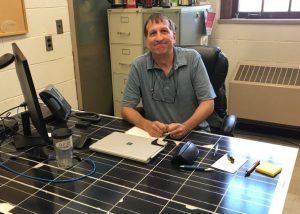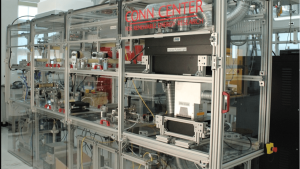
Thad Druffel, PhD, Theme Leader
Solar Manufacturing R&D
Conn Center for Renewable Energy Research
University of Louisville
For the past decade, Thad Druffel has been developing materials and processes for roll-to-roll manufacturing of commercial renewable energy devices, with a particular interest in the use of Pulsed Light. He has written over 20 papers on the subject, and has used XENON systems since 2005. Most recently, he has been researching a breakthrough material for solar cells called perovskite.
I recently had the opportunity to talk with Dr. Druffel, and here is a portion of that interview.
Q: Tell us about your work with perovskite.
A: Perovskite is and important development for solar cells because it’s low cost and it can be deposited by solution phase, so it’s printable. A perovskite cell is about four hundred times thinner than current solar cells made with silicon. Silicon solar cells are about 200 microns (a few human hairs thick), while our perovskite films are just 500 nanometers.
The silicon industry has already driven down the cost of solar. Back in the 70s, no one could afford solar energy. Today, it’s nearly the same cost as coal or natural gas. Now perovskite promises to be far less expensive even than silicon. It has a lower cost on the material side, and it can be printed using high speed presses, so it ends up costing less. As the market heats up, these types of advantages will become significant.

Roll-to-roll press at the Conn Center of Renewable Energy for the printing, sintering and annealing of perovskite film using Pulsed Light by XENON.
Q: Why is Pulsed Light important in this application?
A: You can only anneal perovskite at a certain temperature. Otherwise, you’re going to destroy it. The limit is well under 100C. If you use ovens, you have to heat it slowly for approximately ten minutes, and the oven needs to be long. Pulsed Light does the same job much faster and in a smaller space since it generates high energy without heat. I have a 6-inch roll-to-roll line here at the Conn Center where we print the materials for perovskite solar cells. Then we use Pulsed Light to sinter the metal oxides and anneal the perovskite film.
Q: Have you done a cost analysis of this?
A: Yes, and as a matter of fact this analysis just published. We did a full analysis of the process, including the materials, deposition, and evaporation. Using traditional methods, in addition to the long ovens, you need organic-based solvents instead of water-based, and you need to exhaust the fumes and heat. With Pulsed Light, there are none of these extraneous costs. A meter-long conveyor is all you need, so the cost reductions go well beyond the material itself. There is a real opportunity here to change the economics of solar energy.
Q: Pulsed Light is an established technology. Do you find it transfers well to your current research?
A: Definitely. It’s a proven technology in this type of application—for instance, sintering metallic inks in printed electronics. It’s not breaking new ground in terms of using Pulsed Light. There is a lot of research and practical experience behind it. When you think about it, Pulsed Light is a perfect way to anneal in this application. We’re talking about a material for solar cells that is made for absorbing visible light, and that’s what Pulsed Light produces. We’re using that synergy to our advantage.
Q: How close are we to seeing practical production?
A: There is still research to be done, but we’re making progress. There are several well-funded and well-known companies seeking to incorporate perovskite into devices. These include companies that already have solar cells on the market and are looking for ways to improve their products. There are also startups that want to use perovskite in roll-to-roll manufacturing. Within the next couple of years, I think we’ll see these products starting to hit the market.
_________
Thanks to Dr. Thad Druffel for giving his insights into how perovskite and Pulsed Light are helping to make a brighter future for renewable energy. If you’re interested in using Pulsed Light in your research and development, XENON’s scientists and engineers are ready to work with you. Contact XENON to learn how Pulsed Light can take your application to the next level.
